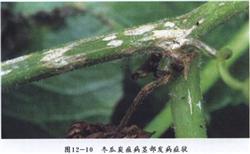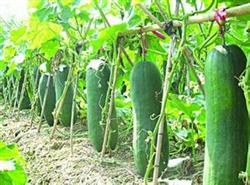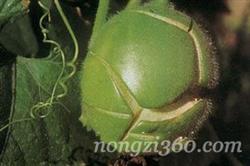Prevention and control of anthracnose of wax gourd

Anthracnose of wax gourd can cause damage to cotyledons, true leaves, petioles, main vines and fruits, especially in fruits. Anthracnose of wax gourd fruit infected with anthracnose mostly occurred at the top, the disease was flooded at the beginning, then gradually expanded, showing a round brown sunken spot, when the humidity was high, pink particles grew in the spot, which was one of the most obvious symptoms of the disease. When seriously ill, the flesh of the melon under the skin turns brown and rotten, causing the wax gourd to lose its commercial value. The disease spot on the leaf is round, brown or reddish brown, surrounded by a yellow halo and light in the center. The size of lesion varied greatly, and there were more plaques with a diameter of 8 mi 10 cm. Too many disease spots cause the leaves to dry up. Anthracnose of Chieh-qua mainly harms leaves, stems and fruits. Most of the fruit infection starts near the melon pedicel, showing a dark green water stain at first, then turning dark brown, slightly sunken, and sticky matter or glue can be seen in the disease spot when the humidity is high. The disease spot of the leaf is round and yellowish brown, the boundary of the disease is not obvious, and there is a yellow halo around the disease spot. Petiole and stem vine disease spot oblong or fusiform, brown slightly sunken, wet when there is amber glue, the disease spot around the vine after a week will appear the disease site contraction, above the affected part withered. Anthracnose of wax gourd and Jiegu is caused by a fungus called Alternaria oryzae. The mycelium or sclerotia overwintered with the diseased remains in the soil, and the conidia spread to melons or plants with wind and rain or irrigation water in the spring of the following year. Seeds can also carry bacteria, after emergence, first infect cotyledons and produce spores for repeated infection. The disease occurs most seriously when the relative humidity is 90%-95% when the disease is about 25 ℃, and the disease condition is the best when planting melons in spring. If the melon vine growth is too dense, poor permeability, poor drainage in the field are easy to cause the disease, post-harvest transportation and storage will also cause the disease. The prevention and control of anthracnose of wax gourd and Jiegu should start from the following aspects: 1. Select disease-free plants to leave seeds, and seeds should be disinfected before sowing. Soak the seeds in 55 ℃ warm water for 15 minutes before cooling, or soak the seeds in 40% formalin for 15 minutes, and then soak the seeds in clean water to accelerate germination. 2. Rotation with non-melon crops. Attention should be paid to the elimination of stagnant water in the field and reasonable close planting, so as to ensure the permeability between plants and reduce the humidity during the melon setting period. And reasonable formula fertilization to improve disease resistance. 3. Pay attention to spraying when the disease spot appears in the leaves to prevent the bacteria from infecting the fruit, especially in the initial stage of setting melon, it must be sprayed and prevented in advance. The available medicaments are: Alcidol (70% wettable powder) 800ml 1000 times; wheeldoc (45% wettable powder) or Dasuanning (75% wettable powder) 600ml 800 times; nitrile azole (12.5% EC) 1000m 1500 times. Choose one of the above agents once every 10 days, spray 2Mel 3 times in a row.
- Prev

Six key points for preservation of wax gourd in kiln
First, select excellent varieties and adopt matching scientific cultivation techniques. Give full play to the characteristics of excellent varieties, improve the stress resistance of the plant itself, and reduce the disadvantages caused by the application of chemical fertilizers and pesticides. Second, organic fertilizer and inorganic fertilizer should be applied together. Apply the best under the condition of being able to do so.
- Next

What about cracked wax gourd?
Wax gourd cracking not only affects the appearance, but also affects the quality and reduces the commodity value. In addition, cracked melon will also cause bacteria to invade the melon and propagate, causing local deterioration or decay of wax gourd, affecting storage and transportation. Select crack-resistant varieties. In rainy areas or rainy seasons, use deep trenches or ridges.
Related
- Where is it suitable to grow horseradish in China? it is expected to see the middle altitude horseradish in Alishan.
- How to prevent tomato virus disease reasonably? (Control methods included)
- Many people like to plant towel gourd on the balcony. What are the main points of this method and management?
- What crops can chili peppers be mixed with?
- Fertilization techniques and matters needing attention in Tomato
- What are the grafting techniques for peach seedlings in spring?
- Harm and control methods of root swelling disease of Chinese cabbage
- What are the pests of sweet potatoes? How to prevent and cure it?
- Symptoms, causes and Control methods of navel Rot in Tomato
- The cause of "Cucumber rotten bibcock" in Farmers' planting Cucumber and its Control Plan

